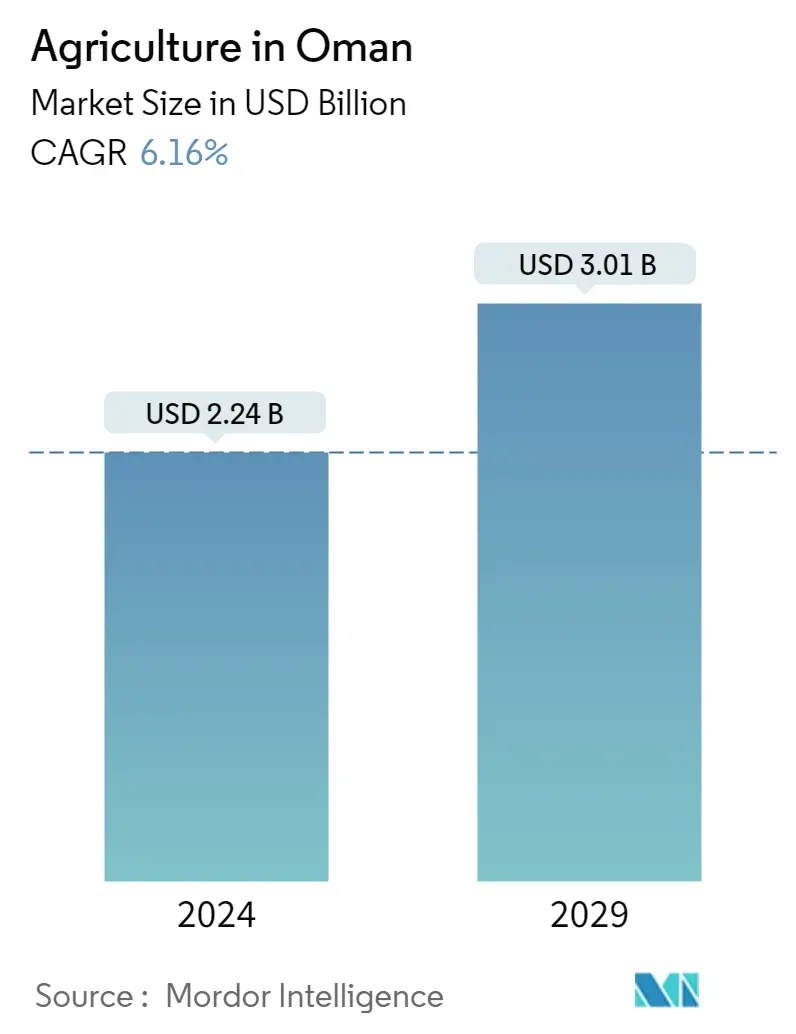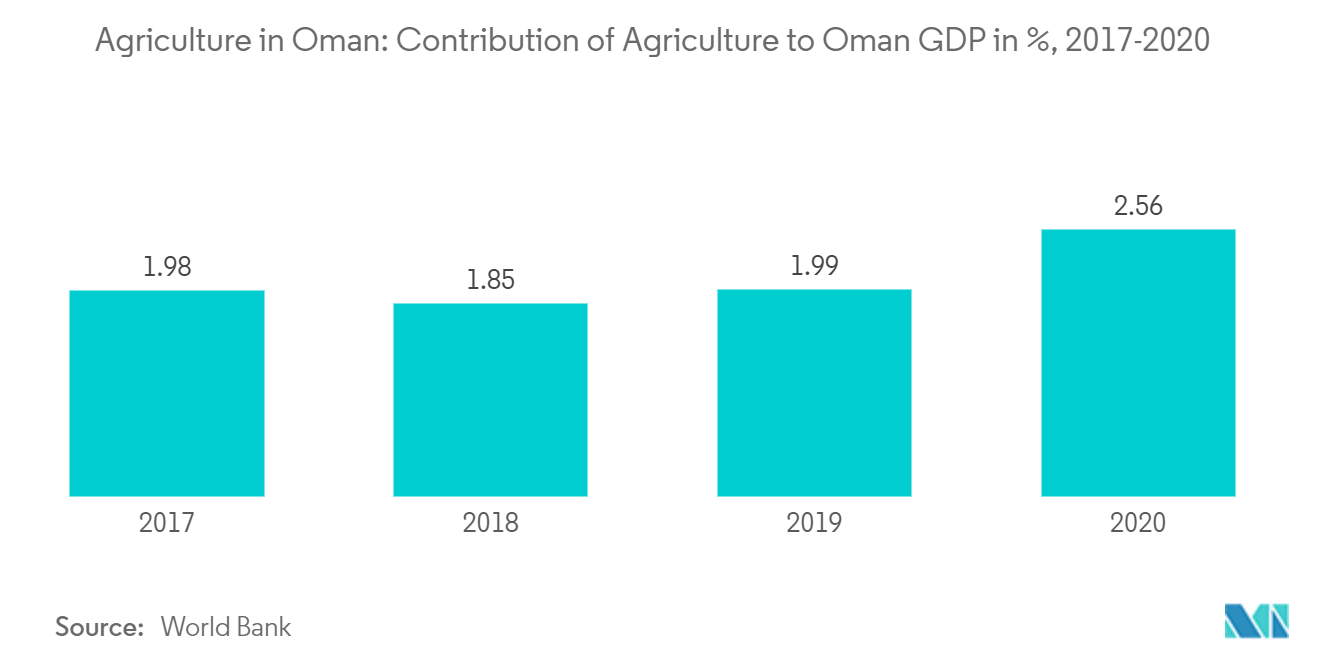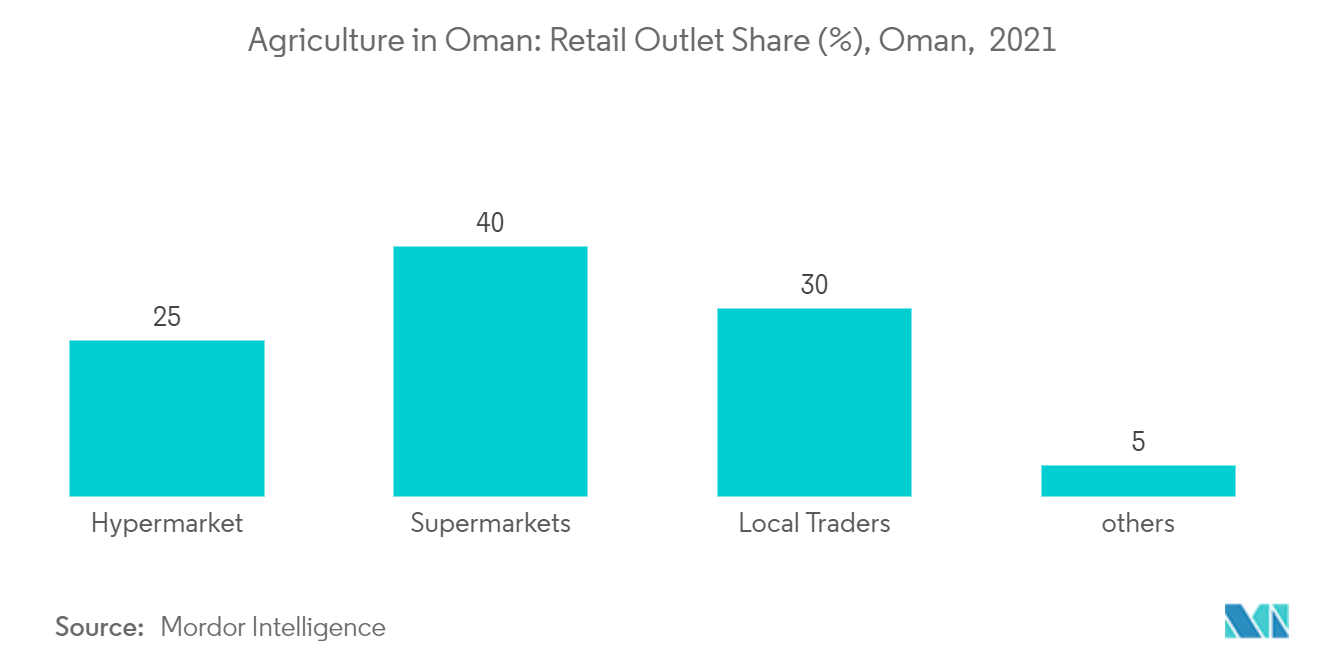Oman Agriculture Market Size

| Study Period | 2019 - 2029 |
| Base Year For Estimation | 2023 |
| Forecast Data Period | 2024 - 2029 |
| Market Size (2024) | USD 2.24 Billion |
| Market Size (2029) | USD 3.01 Billion |
| CAGR (2024 - 2029) | 6.16 % |
Major Players*Disclaimer: Major Players sorted in no particular order |
Oman Agriculture Market Analysis
The Agriculture in Oman Market size is estimated at USD 2.24 billion in 2024, and is expected to reach USD 3.01 billion by 2029, growing at a CAGR of 6.16% during the forecast period (2024-2029).
- The increase in the adoption of advanced farming technologies and conducive government policies supporting domestic crop production are some factors driving the country's market growth. Through imports, Oman meets its domestic fruits, vegetables, and cereals demand. Therefore, to reduce import dependency, the country aims for self-sufficiency in agricultural products by encouraging its farmers to adopt advanced farming techniques.
- Agricultural production in Oman consists mainly of dates, vegetables, and fruits, while other crops are cultivated at lesser volumes. According to world bank statistics, the total amount of agricultural land in Oman was about 1.4 million hectares in 2020, which accounted for 4.7% of the total land area. Fruits like bananas and papaya are also grown in coastal regions, which accounted for 18,447 ton and 5,840 ton of production, respectively, in 2020. Additionally, Oman increased its barley, sorghum, and wheat production in recent years.
- Moreover, the government launched several initiatives to encourage private sector production, such as updating regulations, providing low-interest loans, aiding domestic production, and running campaigns to increase the visibility of locally made products, which is expected to boost the growth of agriculture in Oman during the forecast period.
Oman Agriculture Market Trends
This section covers the major market trends shaping the Oman Agriculture Market according to our research experts:
Government policies of the country to reduce import dependency
Some of the reasons propelling the market expansion in the nation include the rise in the adoption of cutting-edge farming technologies and favorable government policies promoting local crop production. The majority of Oman's local need for fruits, vegetables, and cereals is satisfied by imports. Therefore, the nation is working toward agricultural self-sufficiency by encouraging its farmers to use cutting-edge farming methods in order to decrease import dependency. According to the Official Oman eGovernment Services Portal, to attract more agricultural investments, concerned parties in the government provide many incentives. For instance, if the agricultural project is located in the governorate of Muscat (except Quriyat), Oman Development Bank will lend up to 100% of the capital. Approximately 130% of the capital paid is supplied if the project is constructed outside of the Quriyat or Muscat governorates.
Furthermore, to install contemporary irrigation systems in gardens, the country's agricultural Ministry offers monetary and synthetic loans, Exempting businesses from paying income tax on projects involving agricultural output. The exemption is valid for five years following the production date and may be extended for an additional five years. The government offers loans to customers willing to finance greenhouses, modern irrigation systems, agricultural tractors, agricultural nurseries, date factories, and any other project or service within the agricultural sector in the country. These factors are increasing the agricultural contribution to the GDP of the country. For instance, according to world bank statistics, the contribution of agriculture to Oman's GDP has increased from 1.98 in 2017 to 2.56 in 2020. Therefore, the increase in government initiatives to support the agricultural sector in the country is expected to boost the growth of the agriculture market.

Well established Retail networks are supporting growth of agriculture in the country
The distribution network and retail chains relating to agriculture are expanding consistently in Oman. The Omani retail industry is characterized by strong consumer demand, robust economic growth, distinct demographic factors, and a high-end technology system that ensures better customer service and efficient customer checks.
The increasing presence of major retailers and supermarkets and their aggressive import strategies result in better access to many fruits and vegetables for the Omani population at comparatively cheaper rates. For instance, In 2017, Lulu Hypermarkets alone imported 65 ton of vegetables and bananas to Oman to increase the availability of agricultural produce in the local markets. In 2021, The LuLu Hypermarket Oman opened a new store in Jalan Bani Bu Ali in the South Sharqiya Governorate. This new store will further strengthen the group's presence in the country. It will offer customers a new level of standard in price, convenience, comfort, quality in-store service levels, and a new shopping experience.
Oman Investment Authority announced a new project to market vegetables and fruits in the country under the newly incorporated company Oman Food Investment Holding Company. Under this project, retail outlets are likely to be established in densely populated cities. In addition, SPAR opened a new store in the Ghala business district in Muscat in 2020 as a part of its expansion strategy. This SPAR Supermarket has a total retail sales area of 710 sq. m. and was designed in collaboration with SPAR International. The outlet is dedicated to fresh agricultural products like fruits and vegetables, fish, and meat, among other categories.
Thus, the increase in urbanization rates and hypermarkets have also triggered the demand for high-value processed agricultural foods. Moreover, convenient logistics service provided by retail chains is changing the consumer demand patterns in the market studied in Oman. Hence, the changing retail structure may influence consumer shopping behavior, likely boosting the agriculture market over the forecast period.

Oman Agriculture Market News
- July 2022: The Ministry of Agriculture, Fisheries, and Water Resources (MAFWR) announced that it would distribute free seedlings to encourage Omani farmers to establish commercial model farms and grow various types of fruits. It announced that farmers would be given seedlings of mango and Omani lemon for free, while seedlings of other fruits would be given at a nominal price.
- May 2022: Oman Investment Authority (OIA) and MycoTechnology, Inc. established a joint venture using locally grown dates to produce high-quality mushroom-based protein. The two parties will collaborate on building a state-of-the-art production facility in Oman to scale up and commercialize this novel source of nutritious, sustainable protein.
- May 2021: Majority state-owned Oman Flour Mills, the biggest flour miller in the Sultanate, announced that it is weighing a series of investments and initiatives that will further expand and diversify its presence in the country's rapidly growing processed food industry. It claimed that it plans to introduce a new range of wheat-based products utilizing homegrown wheat for the first time. According to ministry figures, this initiative was expected to open up an attractive domestic market for locally grown wheat, more than 2,200 tons of which were harvested during the last season.
Oman Agriculture Market Report - Table of Contents
1. INTRODUCTION
- 1.1 Study Assumptions and Market Definition
- 1.2 Scope of the Study
2. RESEARCH METHODOLOGY
3. EXECUTIVE SUMMARY
4. MARKET DYNAMICS
- 4.1 Market Overview
- 4.2 Market Drivers
- 4.3 Market Restraints
5. MARKET SEGMENTATION
-
5.1 Crop Type (Production Analysis by Volume, Consumption Analysis by Value and Volume, Import Analysis by Value and Volume, Export Analysis by Value and Volume, and Price Trend Analysis)
- 5.1.1 Cereals
- 5.1.2 Oilseeds
- 5.1.3 Fruits
- 5.1.4 Vegetables
6. INTERNATIONAL TRADE AND PRICE SCENARIOS
- 6.1 Onion
- 6.2 Potato
- 6.3 Tomato
- 6.4 Garlic
- 6.5 Cauliflower
- 6.6 Beans
- 6.7 Eggplant
- 6.8 Lemon
- 6.9 Apple
- 6.10 Banana
- 6.11 Grapes
- 6.12 Strawberry
- 6.13 Watermelon
- 6.14 Dates
- 6.15 Olives
7. REGIONAL ANALYSIS
- 7.1 Value Chain Analysis
- 7.2 Government Policies
8. COMPETITIVE ANALYSIS
- 8.1 Distribution Network and Retail Analysis
- 8.2 List/Profile of Key Players
9. MARKET OPPORTUNITIES AND FUTURE TRENDS
** Subject To AvailablityOman Agriculture Industry Segmentation
Oman is recognized for its rich agricultural diversity involving almost all crop species. The Oman agriculture market report is segmented by type (cereals, oilseeds, fruits, and vegetables). The report includes production analysis (volume), consumption analysis (value and volume), export analysis (value and volume), import analysis (value and volume), and price trend analysis. The report offers market size and forecasts regarding value (USD million) and volume (ton) for all the above segments.
| Crop Type (Production Analysis by Volume, Consumption Analysis by Value and Volume, Import Analysis by Value and Volume, Export Analysis by Value and Volume, and Price Trend Analysis) | Cereals |
| Oilseeds | |
| Fruits | |
| Vegetables |
Oman Agriculture Market Research FAQs
How big is the Agriculture in Oman Market?
The Agriculture in Oman Market size is expected to reach USD 2.24 billion in 2024 and grow at a CAGR of 6.16% to reach USD 3.01 billion by 2029.
What is the current Agriculture in Oman Market size?
In 2024, the Agriculture in Oman Market size is expected to reach USD 2.24 billion.
What years does this Agriculture in Oman Market cover, and what was the market size in 2023?
In 2023, the Agriculture in Oman Market size was estimated at USD 2.11 billion. The report covers the Agriculture in Oman Market historical market size for years: 2019, 2020, 2021, 2022 and 2023. The report also forecasts the Agriculture in Oman Market size for years: 2024, 2025, 2026, 2027, 2028 and 2029.
What are the logistical considerations for exporting agricultural products from Oman to international markets?
The logistical considerations for exporting agricultural products from Oman to international markets are a) Transportation infrastructure b) Cold chain management
Farming in Oman Industry Report
The report on Agriculture in Oman Market highlights the significant role this sector plays in the national economy. With a focus on reducing import dependence and enhancing domestic crop production, the market is poised for substantial growth. The market segmentation covers cereals, oilseeds, fruits, and vegetables, with production and consumption analysis provided in terms of value and volume. The report also includes export and import analysis, along with price trend analysis.
Governmental policies are crucial in driving this growth, offering financial incentives and tax breaks to upgrade agricultural infrastructure, including irrigation systems and greenhouses. These efforts aim to increase self-sufficiency in key agricultural products such as dates, vegetables, and fruits. The market size and forecasts are detailed in the report, reflecting the increasing contributions of agriculture to the country's GDP.
The expansion of retail networks and supermarkets is making agricultural produce more accessible, reshaping consumer buying patterns and enhancing the market presence of agriculture farms in Oman. Industry statistics and market research indicate a positive industry outlook, with growth rate projections and industry trends suggesting a robust future for the sector.
For a comprehensive understanding, the report provides an industry analysis, highlighting the market structure and industry growth. Detailed market data, market forecast, and market review are included to offer a thorough market overview. The report pdf is available for those seeking in-depth industry information and market predictions.
The report also identifies market leaders and provides insights into market segmentation and market value. Research companies have contributed to this extensive industry research, ensuring that the data is accurate and reliable. The industry size and industry sales figures are crucial for understanding the market dynamics.
In summary, the Agriculture in Oman Market report is an essential resource for stakeholders, offering detailed market analysis and growth forecasts. The report example and report pdf provide valuable insights into the market's potential, driven by supportive governmental policies and expanding retail networks. This comprehensive analysis ensures that stakeholders are well-informed about the market's trajectory and opportunities for investment.



